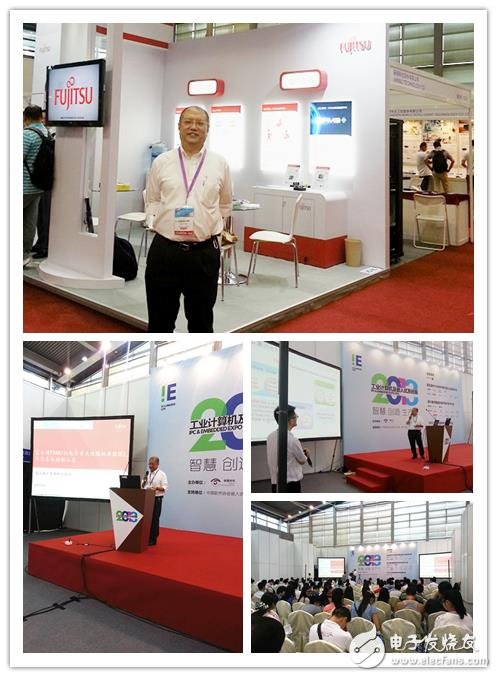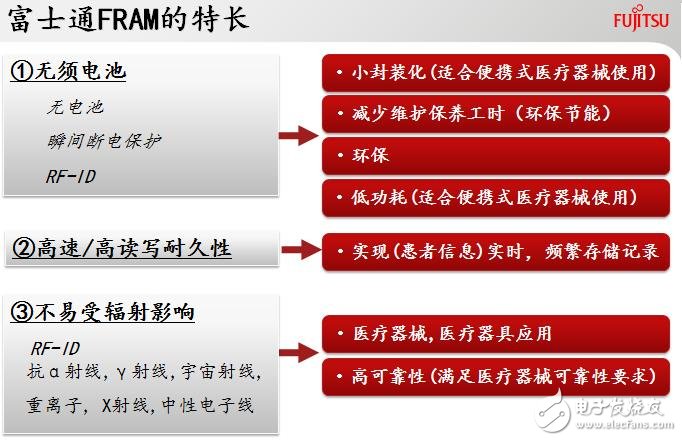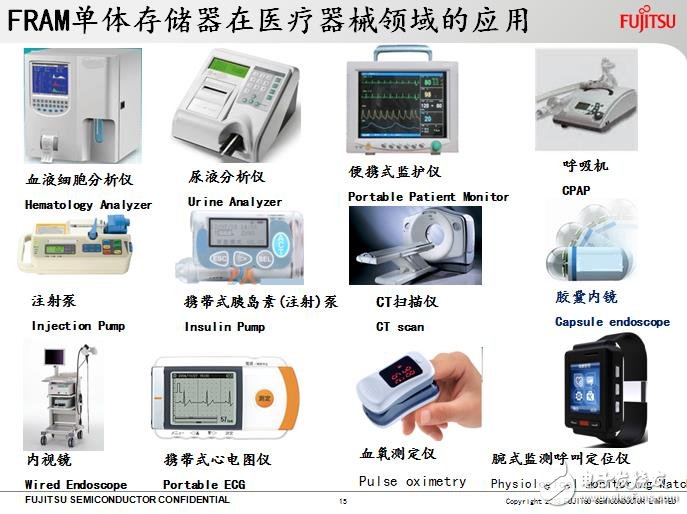"Human lives are close to heaven"-FRAM's application status in medical equipment
In the recently released movie "Pacific Rim", in the face of the monster's shock wave, the mecha warriors controlled by digital circuits were instantly paralyzed, and only the analog circuits were carried down. This can be used visually to show that whether electronic components can resist radiation is sometimes a matter of human life! Returning to reality, in the field of medical electronics, non-volatile random access memory that can resist up to 50kGy gamma ray sterilization-FRAM is suitable for some key medical equipment that lives with life.
"Actually, FRAM is not only resistant to radiation, but its high-speed / high read-write durability (more than one trillion cycles) and low power consumption are also important reasons why it can become the best memory choice in medical applications." Fujitsu Semiconductor Mr. Miyamiya Masato, Vice President of the System Memory Division, said at the 6th China International Medical Electronics Technology Conference (CMET2013) held in Shenzhen a few days ago. He made a special trip to Shenzhen from Japan to deliver a keynote speech entitled "Battery-free storage solutions in medical applications."

Figure 1: Fujitsu Semiconductor's Vice President of Semiconductor Memory Division, Mr. Miyamiya, gave a speech at the 6th China International Medical Electronics Technology Conference (CMET2013).
Using FRAM to overcome medical storage technology challenges
FRAM (Ferroelectric Random Access Memory) combines the characteristics of traditional non-volatile memory flash memory and E2PROM can still save data when power is off, and achieves the reading and writing speed of SRAM / DRAM. It is an independent memory chip and embedded memory. Come to a series of unique advantages. Fujitsu is a pioneer in FRAM technology and has been working in this field for more than 10 years. Mass production has started in 1999. It has sold 2.3 billion FRAM products in 14 years, of which more than 53 million have been delivered in the Chinese market.
In the past five years, some new types of non-volatile memory technologies such as FRAM, PRAM, ReRAM, and MRAM have continuously emerged, but only FRAM has achieved excellent market mass production performance. Excluding some low-end application markets, FRAM has performed well and has a good reputation in applications that require non-volatile storage, high security, high speed, low power consumption, durability, and radiation resistance. In the medical field, the application of FRAM is particularly noticeable in some important occasions where people are killed, such as ventilators and other equipment.
Mr. Masatoshi Matsunomiya introduced the current status of FRAM in the medical field at the conference: "Although FRAM is currently commercialized in the medical field, it is still in its infancy from a broad perspective. Compared to the Japanese and European markets, FRAM The recognition in the Chinese market still needs to be improved, and in the future Fujitsu Semiconductor will also increase investment in medical applications to help more Chinese medical equipment manufacturers solve their data storage challenges. "
Figure 2 below highlights the three key advantages of FRAM for medical applications, which does not require a battery backup feature making it particularly suitable for the use of portable medical devices, while reducing equipment maintenance costs; and high speed / high read and write Durability allows patient information to be stored and recorded frequently in real time; the anti-radiation characteristics meet the requirements for high reliability of medical devices.

Figure 2. Three advantages of Fujitsu Semiconductor FRAM for medical applications.
The relative cost advantage of EEPROM is disappearing
Compared with traditional non-volatile memory such as EEPROM, the advantages of Fujitsu FRAM are mainly reflected in high-speed programming (40, 000 times that of EEPROM), high endurance (1, 000 times that of EEPROM), and low power Consumption (which is 1 / 1,000 of EEPROM) and other aspects. These advantages make FRAM more and more used in applications that require high reliability, such as measuring instruments (three-phase electricity meters and water meters, gas meters, etc.), power automation, medical devices and medical electronic labels, automotive after-installation equipment, POS machine / financial ATM machine, etc.
In addition to being able to replace EEPROM in some applications, FRAM is more important to realize functions that EEPROM cannot achieve in some key medical applications. For example, in the fields of medical and biological treatment involving CT scanning X-rays, ultraviolet rays and gamma rays for disinfection, as mentioned above, FRAM is very resistant to radiation. FRAM-based RFID can easily pass the standard medical sterilization process, and EEPROM-based RFID will be erased during this process.
Regarding the cost of FRAM, Mr. Masatoshi Miyanomiya also expounded his point: "This is related to storage capacity, different capacity and different prices. Now the general price gap between FRAM and EEPROM is 2 to 5 times, while in large capacity In terms of, for example, the price gap between FRAM and EEPROM between 1M and 2M is not large, only 1 to 2 times, so in large-capacity applications, the price of EEPROM is not dominant, and will be replaced by FRAM in the future. "
On the other hand, due to the control of the entire research and development of FRAM, wafer production and packaging processes, combined with years of experience, Fujitsu Semiconductor can always guarantee the high quality and stable supply of FRAM products. Fujitsu Semiconductor is also continuously innovating in low-power manufacturing processes, further reducing cost and price, and achieving large capacity. Relatively speaking, the manufacturing process of EEPROM has not changed for a long time. Over time, the cost advantage of EEPROM will gradually weaken.
FRAM is 100% used in life-related medical equipment
"Excluding some very cheap low-end application markets, FRAM has 100% applications in medical equipment that requires high reliability, high-speed / high durability data reading and writing, low power consumption, and radiation resistance." Song Mr. Gong further pointed out.
Let's follow Mr. Masao Miyanomiya to the hospital to see, what equipment is used in Fujitsu Semiconductor's FRAM? And why is FRAM closely related to our lives?

Figure 3. Application of FRAM single memory in the field of medical devices.
A common feature of these applications shown in Figure 3 above is that there is no need for a separate battery to provide uninterrupted power to the memory. This is one of the main contents of Mr. Miyamiya's speech-"Battery-free storage solution in medical applications". For different medical devices, Fujitsu Semiconductor has corresponding product models that can be applied. The following lists the specific product models recommended by the FRAM expert for different applications and the benefits of using FRAM.
Reverse Conducting Thyristor(RCT) is also called Reverse- appreciation Thyristor.The characteristic is that a diode is connected in reverse parallel between the anode and cathode of thyristor, so that the transmitting junction of anode and cathode is short-circuited.As a result of this special circuit structure, it has high voltage resistance, high temperature resistance, short turn-off time, low switching voltage and other good performance.For example, the turn-off time of the reverse thyristor is only a few microseconds, and the working frequency is dozens of KHZ, which is better than the fast thyristor (FSCR).This device is suitable for switching power supply and UPS uninterrupted power supply. One RCT can replace one thyristor and one continuous current diode respectively.
Reverse Conducting Thyristor(RCT)
Reverse Conducting Thyristor,Original Reverse Conducting Thyristor,New Reverse Conducting Thyristor,Reverse-Conducting Thyristor 2200V
YANGZHOU POSITIONING TECH CO., LTD. , https://www.yzpst.com
